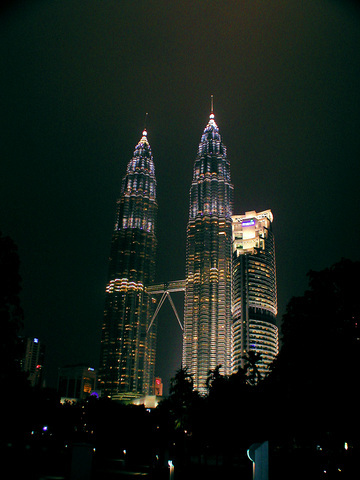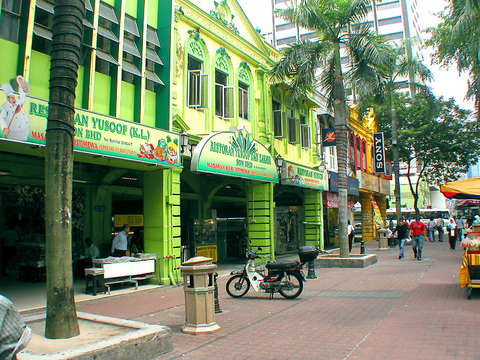Like many Southeast Asian metropolises, Kuala Lumpur is a city of contrasts and dazzling contradictions. Cookie-cutter commercial outlets stand beside repositories of rich cultural heritage, while the architecture of break-neck global capitalism -- exemplified by the Petronas Towers -- looms over ramshackle neighborhoods bursting at the seams with the buzz of local culture and life.
For the visitor passing briefly through Kuala Lumpur, the mix of Malay, Indian, Chinese, Thai and other cultures native to Malaysia can be extremely daunting to take in, much less understand in any comprehensive or coherent fashion.
But the following itinerary of major and minor sights in and around the city can give the harried traveler a glimpse into the country's colorful culture in the space of a single day.

PHOTO: TAIPEI TIMES
Batu Cave
On the northern outskirts of Kuala Lumpur is a major Hindu holy site named Batu Cave and located inside a limestone hill. A temple dedicated to the Hindu deity Subramaniam is located in the back of the cave, which is reached by climbing exactly 272 stairs to the grotto's mouth. Rascally monkeys can be seen on the staircase and inside the cave, where barriers have been installed to prevent them from throwing objects onto pilgrims below. The world's tallest Hindu religious sculpture is currently under construction at the base of hill.
Central Market

PHOTO: TAIPEI TIMES
Formerly the city's main covered market, Central Market has undergone major changes in recent decades and is now heavily frequented by tourists, which is reflected in the shops dedicated to selling items of interest mainly to this group. The building's colonial architecture, which has been thoughtfully preserved and extremely well maintained, is the highlight of the market, but the knick-knacks sold within make for perfect Malaysian gifts.
Petaling Street
Practically down the street from Central Market lies Petaling Street, the heart of the city's bustling Chinatown. It's here that Malaysians and tourists alike mingle to buy a dizzying array of knock-off goods, including faux Rolex watches, Gucci bags, Nike shoes and next week's Hollywood releases out already in this market on DVD. Police make rather desultory efforts to shoo away the more flagrant rule violators who set up in the middle of the street, and one amusing way to rest tired shopper's feet at the market is to sit at one of the many Chinese tea stalls and observe the cat-and-mouse game the vendors play with police.

KL-Tower
In the heart of town, not far from Petaling Street stands KL-Tower, a 421m-tall telecommunication tower that also houses a revolving restaurant. A full revolution in the restaurant takes about one hour so that a panoramic view of the city can be viewed during a leisurely meal. Of special note at the tower is an extraordinary mirror mosaic at the mezzanine level. The mirror was donated by the government of Iran and is a sublime example of the geometric elegance of Islamic art.
Petronas Towers
The crown jewel of Kuala Lumpur's skyline, the 452m-tall twin Petronas Towers were the tallest buildings in the world until Taipei 101 recently usurped that honor. But what the towers now lack in height to Taipei 101, they more than make up for in aesthetic beauty. Light at all times of day and night reflects off the towers' stainless-steel facades in ever-changing shades of silver to create an effect that is simply mesmerizing. A monument to globalization, the towers were designed by an Argentine and constructed by South Korean and Japanese contractors using American materials. A large park at the base of the towers provides the ideal spot from which to gaze at these spectacular buildings, or to get a closer look, visitors can take a free elevator to the bridge level at 170m, where there is also a restaurant and cafe
KL Monorail
Kuala Lumpur boasts a top-rate mass transit system, with commuter trains, buses and an immaculate monorail line putting much of the city within easy striking distance. The monorail is not to be missed for visitors, as it cheaply and safely provides an elevated, air-conditioned and leisurely way to wind through the city's central districts.

On April 26, The Lancet published a letter from two doctors at Taichung-based China Medical University Hospital (CMUH) warning that “Taiwan’s Health Care System is on the Brink of Collapse.” The authors said that “Years of policy inaction and mismanagement of resources have led to the National Health Insurance system operating under unsustainable conditions.” The pushback was immediate. Errors in the paper were quickly identified and publicized, to discredit the authors (the hospital apologized). CNA reported that CMUH said the letter described Taiwan in 2021 as having 62 nurses per 10,000 people, when the correct number was 78 nurses per 10,000

As we live longer, our risk of cognitive impairment is increasing. How can we delay the onset of symptoms? Do we have to give up every indulgence or can small changes make a difference? We asked neurologists for tips on how to keep our brains healthy for life. TAKE CARE OF YOUR HEALTH “All of the sensible things that apply to bodily health apply to brain health,” says Suzanne O’Sullivan, a consultant in neurology at the National Hospital for Neurology and Neurosurgery in London, and the author of The Age of Diagnosis. “When you’re 20, you can get away with absolute

May 5 to May 11 What started out as friction between Taiwanese students at Taichung First High School and a Japanese head cook escalated dramatically over the first two weeks of May 1927. It began on April 30 when the cook’s wife knew that lotus starch used in that night’s dinner had rat feces in it, but failed to inform staff until the meal was already prepared. The students believed that her silence was intentional, and filed a complaint. The school’s Japanese administrators sided with the cook’s family, dismissing the students as troublemakers and clamping down on their freedoms — with

As Donald Trump’s executive order in March led to the shuttering of Voice of America (VOA) — the global broadcaster whose roots date back to the fight against Nazi propaganda — he quickly attracted support from figures not used to aligning themselves with any US administration. Trump had ordered the US Agency for Global Media, the federal agency that funds VOA and other groups promoting independent journalism overseas, to be “eliminated to the maximum extent consistent with applicable law.” The decision suddenly halted programming in 49 languages to more than 425 million people. In Moscow, Margarita Simonyan, the hardline editor-in-chief of the